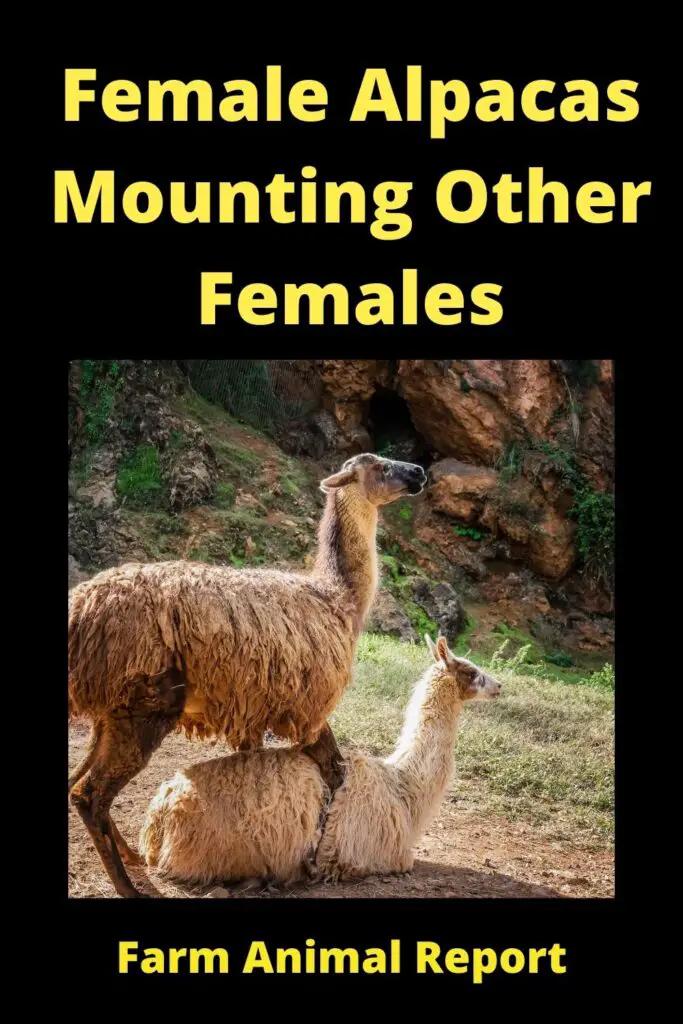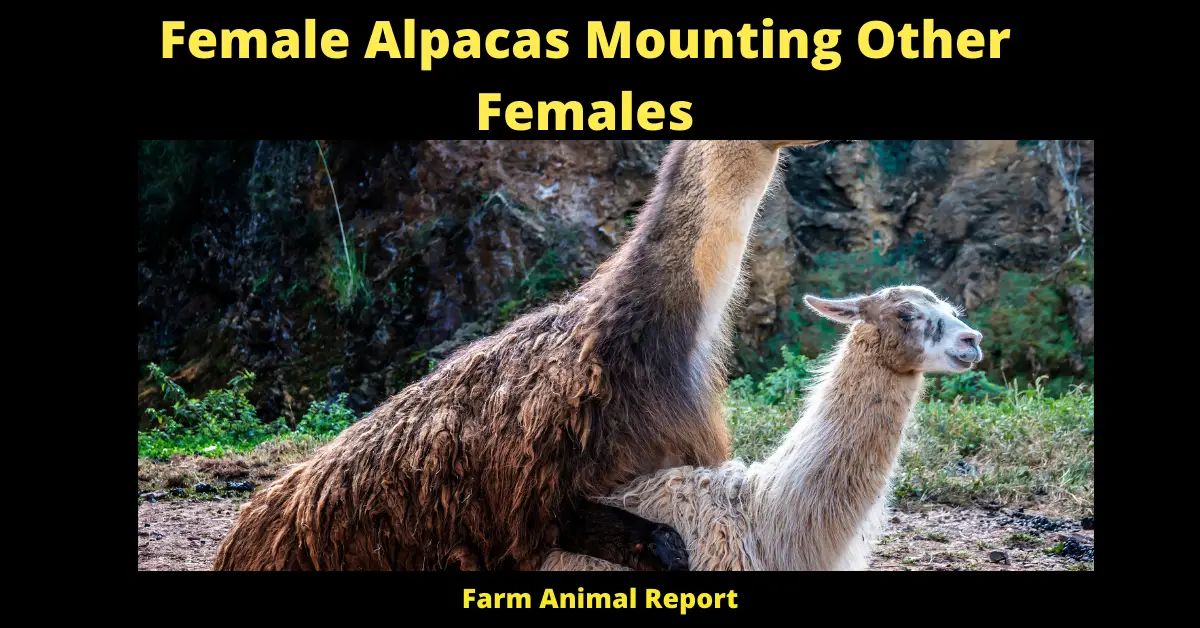Female Alpacas Mounting Other Females
As a General rule Female alpacas are sexually promiscuous and will mount one another. Female alpaca mounts typically last about three seconds and the female may move her hips in a circular motion before she dismounts. Female mounting is less common than males mounting females but it does happen from time to time because of their sexual promiscuity. They will do this when they come into their heat cycle. A Female will come into heat every 12 to 21 days and it will last anywhere from a few hours up to two or three days. If they do not mate during this time, they may go into heat again after about six weeks of the first cycle. Female alpacas in heat can be very persistent and relentless by following herds around until they find a male that is ready for mating. If they are not able to breed with a male, female alpacas will continue humping other females
Why do Female Alpacas mount other Female Alpacas?
Why do Female Alpacas mount other Female Alpacas? – Female alpacas will mount each other for a number of reasons, including sexual arousal and establishing dominance. Female alpacas can become sexually aroused by looking at other female alpacas, smelling the urine of another female, or even just being around them. Female alpacas are sometimes submissive to their herd’s lead female so they will follow her and be led into mounting behavior. Female dominance is also a large factor in the phenomenon of Female Alpacas Mounting other Female Alpacas. Female alpacas will mount one another to establish dominance and can even go as far as fighting for the top spot in their herd’s hierarchy with teeth, hooves, tails raised high into the air, or ears spread wide.
Aggressive Female Alpaca Behavior Female
Alpacas can be aggressive, especially when it comes to their reproductive needs. Female alpacas that are not able to breed with a male will start mounting other females in the herd or flock as they try and go into heat. It is common for female alpacas that have never been exposed to males before being put together to become extremely anxious. Female alpacas will start mounting another female in the flock to show dominance and establish a pecking order. Female alpaca behavior can sometimes be mistaken for fighting, however, it is important not to separate them from each other because this could cause further problems with their hormones being out of balance.
When females do fight it is generally because of a lack of space, food, or water. Female alpacas are known as herd animals and they do not like to be left alone for long periods of time. If they have been separated from their flock it is important to reintroduce them slowly by mixing the new female in with another group. Female adult alpacas can live up to 15 years so do not separate them unless it is absolutely necessary. Female alpacas are known for being very social animals and they can become extremely stressed if separated from their herd or flock.
18 ways Alpaca Farmers make Money
Female Alpaca in Heat
Female Alpacas mounting other females – When a female Alpaca comes into heat she will rub her tail to one side and stand in an open stance for the male. Female alpacas that are ready to breed with a male will start sniffing around him, alerting him of their readiness by releasing pheromones through their vaginal area which is what he uses to detect when she is ready. Female alpaca behavior shows that she is fertile and ready to mate by standing still while the male mounts her from behind. Female alpacas reach sexual maturity at around seven months of age, however, it can take up to a year for them to come into heat for the first time. Female alpacas are able to reproduce at around two years of age. Female alpaca behavior that is not related to mating or reproduction can be caused by other factors. Female alpacas exhibiting these behaviors may just need more attention, be anxious because they have been separated from their herd mates, feel threatened in some way, or simply want a treat. Female alpacas that are pregnant will often lay down and get up frequently, eat more than usual but sometimes show no major changes in behavior.

Signs of Female Alpaca in Heat are subtle
The female will not exhibit any physical changes or show signs of aggression, however, she may start ramming other alpacas in the herd to let them know her dominance over them and that they need to back off. If a male is available he will mount from behind while sniffing around at the same time but otherwise females are able to mount one another.
A Female will come into heat every 12 to 21 days and it will last anywhere from a few hours up to two or three days. If they do not mate during this time, they may go into heat again after about six weeks of the first cycle. Female alpacas in heat can be very persistent and relentless by following herds around until they find a male that is ready for mating. If they are not able to breed with a male, female alpacas will continue humping other females in the flock or herd until their hormones start to balance out again.
Female Alpacas Fighting other Females
Alpacas fight with each other too, sometimes during mating season. Female alpacas have a hierarchy in their herds just like most wild animals do. Female alpacas will also mount and hump the backs of other female alpacas to show dominance over them. This is a behavior that can be seen pretty frequently among females when they are in heat. Female alpacas can even go as far as to try and mount males if they are not kept separated from the females by a fence. Female alpacas will also fight with each other, but it happens less frequently than male-female fights do.
Female Alpaca Behavior
Female alpacas display a wide range of behaviors that can tell you about their feelings and needs.
- Alpacas show concern by nickering or humming when they see another alpaca in distress. They may try to soothe the other alpaca with gentle nose touches and hugs, too!
- Females can be moody during their cycles, but this is totally normal for them. It’s best not to handle them too much during this time.
- Female alpacas show affection by rubbing their noses together, which is called “bunting”. They also do it to objects as well!
- Alpaca females are very sensitive creatures and can become stressed easily from even small things. Make sure they have a calm environment without too many people or loud noises around them.
- If you see a female alpaca pacing and running, it means she’s in “heat”. Males will chase her during this time because they want to mate with her!
- Females always kick out their hind legs when they lay down, but sometimes females do this for fun as well. It can be cute to watch, too!
- If she’s crotching or standing with her head low and back arched up, it could mean that she is having a hard time getting comfortable. Check to see if there are any rocks or sharp objects in the area where you keep them so they can’t get hurt. If not, check their food and water to make sure they have enough.
- Females show dominance by standing tall over another alpaca as if saying “I’m the boss here!” If a female sees something interesting or new, she may stretch her neck out in front of other alpacas that are nearby too. This is called an “extended posture” and it is a way of showing off!
- When an alpaca female has her head stretched out and looking far away, she’s probably smelling something new and interesting. If you see this behavior, look to see what might be there because chances are that other alpacas will want to check it out too. This can help you find new objects or animals that you didn’t know we’re around.
- If an alpaca female is looking at her tail, she’s probably going to have a bowel movement soon! They always do this before they defecate so it can be helpful information if you pay attention and learn what behavior means what. If a male alpaca is standing nearby, it means that he’s interested in mating with her. If she lays down to have a bowel movement, he might follow and try to mount her!
- Females often walk around the pasture at night or early morning hours because they are most active during these times of the day. This behavior can be seen more if there are no other alpacas around, but there are some days when they might be more social.
- If an alpaca female is looking at you and has her ears pointed forward, she’s not feeling threatened by your presence! This means that it will probably be safe to pet them or move closer if you want to say hi.

What is an Open Female Alpaca
An open female behavior is when an alpaca stands with her legs spread apart and shows a lot of interest in the male. The male will take this as a sign that she’s ready to mate, so he moves up behind her and holds on tightly around her midsection while mating begins.
If you see your alpaca standing like this, don’t be too alarmed as it doesn’t mean she is ready to give birth. In fact, female alpacas only show interest in mating when they are not pregnant or lactating and have a long breeding season ahead of them. If the male isn’t around, an alpaca might just display this behavior as a way of relieving sexual tension.
If she is not ready to breed she will not stand for the male but move away or refuse his advances.
When is a Female alpaca too old to Breed ?
A Female alpaca generally is too when she stops coming into estrus, or when she has not come into estrus after a certain period of time.
She will stop coming into estrus if she is too old to breed because her reproductive organs have stopped working properly. It’s normal for an alpaca doe (female) to be able to reproduce until the age of 12 years old, however, they are usually most productive until the age of about seven years old.
When an alpaca doe is too old to breed she will stop cycling, and it may be difficult for her to become pregnant even if bred by a male with superior genetics (in other words: one that has good conformation ). If you plan on keeping this female alpaca for a while, it might be best to have her spayed so that she does not develop health problems associated with being in constant estrus.
Are Male or Female Alpacas Better for Pets?
Male alpacas are more popular as pets. Female alpacas take less space and eat less, but they may be harder to handle because of their mood swings during their monthly cycle (similar to humans). Females also make a lot of noise when in heat. Males tend not to make any sound at all unless fighting for dominance with another male or during mating season.
Having the Male Alpaca neutered can help reduce their hormones and make them easier to handle. It may be advisable for the neuter procedure to happen at an early age so that they are not as dominant or aggressive when older.
Having two alpacas, one male and one female is ideal for balancing out each others’ moods/behaviors during their cycle periods. However, having two males can be very aggressive.
What Age can a Male Alpaca Breed?
Alpacas are not sexually mature until 18 to 24 months. They will be able to breed at around four years of age. A female alpaca can give birth as early as 12 or 13 months, however she is usually about two and a half before she starts breeding again.

Final Thoughts
There is nothing to be worried about if one of your female alpacas is mounting other females. This is a behavior that happens when there are no males present and will stop once they do not see any other alpacas in heat.


